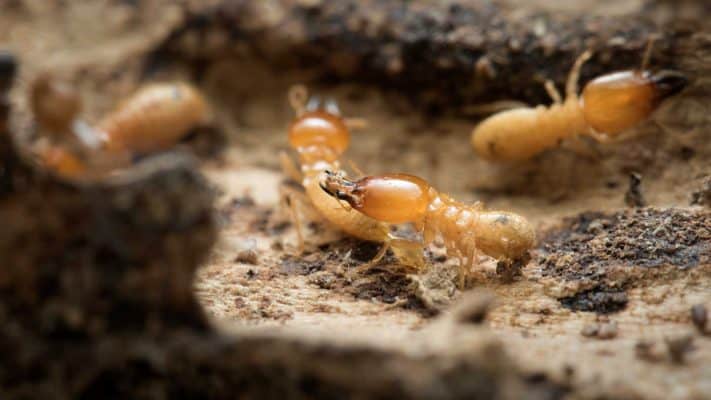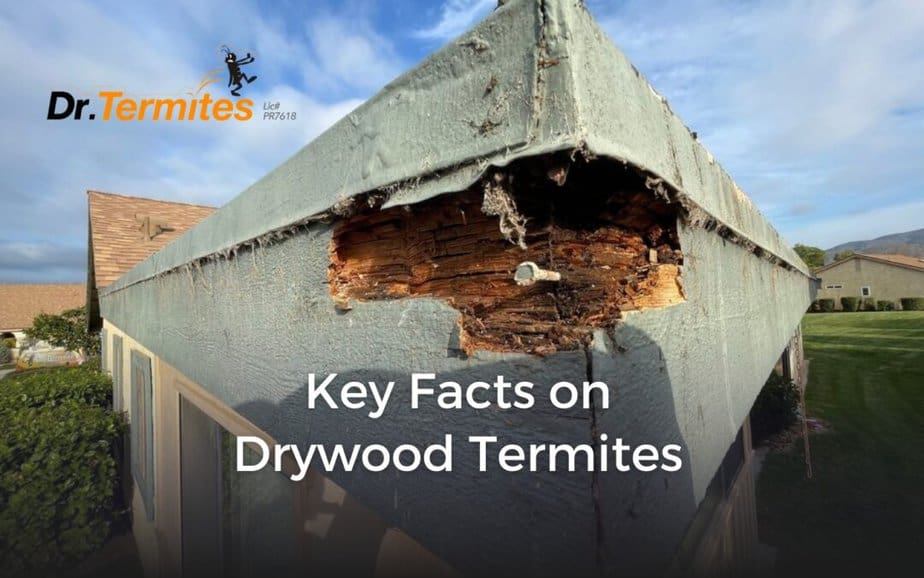Did you know that drywood termites are some of the hardiest creatures known to man, requiring no more than the moisture it gets from the wood that it eats?
Truly, drywood termites are fascinating creatures. But, for homeowners dealing with drywood termites, they’re anything but.
When it comes to termite control in Ventura, CA, dealing with drywood termites can be a nightmarish situation. These pests can cause extensive damage to wooden structures, furniture, and other items made of wood.
This article aims to provide comprehensive information on drywood termites, helping you understand their habits, how to identify them, and effective methods to get rid of them.
Understanding Drywood Termites
Drywood termites are a type of termite that infest dry wood. Unlike subterranean termites that require contact with soil, these pests live and feed inside the wood they infest. They don’t need any contact with the ground, which means they can establish colonies in a variety of wooden structures including homes, furniture, and even picture frames.

Behavior and Habits
Behaviour and Habits Drywood termites are known for their stealthy nature. They often go unnoticed until they have caused significant damage. These insects prefer dry conditions and can extract moisture from the wood they consume. This makes them particularly challenging to detect since there are no external signs like mud tubes which are common with other termite species.
Life Cycle
The life cycle of drywood termites includes three main stages: egg, nymph, and adult. The queen can lay thousands of eggs during her lifespan. Once the eggs hatch, the nymphs go through several molts before reaching adulthood. The entire process can take several months to a year, depending on environmental conditions.
Identifying Drywood Termite Infestations
Recognising the presence of drywood termites early on is critical in preventing extensive damage to your property.
Signs of Infestation
- Frass: Drywood termites produce distinctive faecal pellets, known as frass, which are often found in small piles near the infested wood. These pellets are usually hexagonal and resemble grains of sand or sawdust. The presence of frass is a clear indication of termite activity within the wood.
- Kick-out Holes: These termites create tiny holes in the wood to push out their frass. These ejection points, also known as kick-out holes, are typically small and round, often appearing on wooden surfaces. Spotting these can indicate an active infestation inside the wood.
- Swarmers: Winged termites, or swarmers, are reproductive termites that leave the colony to start new ones. These swarmers are attracted to light and are often found near windowsills or light fixtures. Discovering discarded wings in these areas can be a sign of an infestation.
- Wood Damage: Drywood termites consume wood from the inside out, which can lead to significant structural damage. Tapping on infested wood may produce a hollow sound, indicating that the interior has been compromised. Additionally, you may notice blistering on wooden surfaces, which suggests internal cavities created by termites.
- Termite Droppings: These pests leave behind droppings that can resemble coffee grounds or pepper. Finding these droppings around wooden structures is another sign that termites may be present.
Inspection Techniques
Effective inspection techniques are essential for identifying drywood termite infestations.
Here are some methods used by professionals:
- A thorough visual examination of wooden structures can reveal signs of termite activity. Look for visible damage, kick-out holes, and frass piles. Inspect areas that are prone to moisture, as termites are attracted to damp wood.
- Lightly tapping wooden surfaces with a hammer or screwdriver can help detect hollow areas that indicate internal damage. If the wood sounds hollow or produces a dull thud, i
- Moisture meters measure the moisture content within wood. Termites require moisture to survive, so higher moisture levels can indicate potential problem areas. Professionals use moisture meters to identify sections of wood that may be at risk.
- A borescope is a tool with a small camera on the end of a flexible tube, allowing inspectors to look inside walls and other hard-to-reach areas without causing damage. This tool is particularly useful for detecting hidden termite activity within wooden structures.
- Acoustic Emission Devices detect the sounds produced by termites as they chew through wood. By amplifying these sounds, inspectors can pinpoint areas of activity that might not be visible to the naked eye.
- Infrared thermography can be used to detect temperature variations in wood structures. Termite colonies generate heat, and infrared cameras can identify these heat signatures, helping to locate infestations behind walls and other concealed areas.
- Using a sharp instrument like an awl or screwdriver, inspectors can gently probe wooden structures to check for soft spots and internal cavities caused by termite activity. This method helps confirm the extent of the damage.
- Specially trained dogs can detect the scent of termites with remarkable accuracy. These dogs can be used to inspect large areas quickly and efficiently, making them a valuable asset in termite detection.
Treatment Options for Drywood Termites
Regular monitoring is crucial in keeping drywood termite infestations under control. Homeowners should perform periodic checks of wooden structures, especially in areas prone to infestations such as attics and basements.
But, in case of an actual infestation, these are the most common treatment options available to homeowners and business owners:
Spot Treatments
Spot treatments are ideal for localized infestations. These involve injecting termiticide directly into the infested wood. This method is effective but may not be suitable for large infestations.
Fumigation
Fumigation is a comprehensive method used to eliminate drywood termites from an entire structure. During this process, the building is covered with a tent and a gas fumigant is released inside, permeating all wood within the structure. This method ensures that all termites are eradicated.
Heat Treatments
Heat treatments involve raising the temperature of the infested area to a level that is lethal to termites. This method is effective and environmentally friendly.
Wood Treatments
Applying borate-based products to wood can prevent infestations. These treatments penetrate the wood and create an environment that is inhospitable to termites.
Choosing the Right Professional Exterminator
Selecting the right professional exterminator is crucial for effectively managing a drywood termite infestation. With numerous options available, making an informed choice ensures that your property receives the best possible care.
Here’s how to choose the ideal exterminator for your needs.
Experience and Expertise
When looking for professional termite control in Ventura, CA, it’s essential to choose a company with experience and expertise in dealing with drywood termites. Look for companies that have positive reviews and a proven track record.
Certifications and Training
Certifications serve as a testament to an exterminator’s proficiency. Ensure that the professionals you consider hold relevant certifications from recognised pest control authorities. These certifications indicate that they have undergone rigorous training and adhere to industry standards. Additionally, inquire about ongoing training and continuing education, which helps exterminators stay updated with the latest techniques and technologies.
Licensed and Insured
Ensure that the exterminator is licensed and insured. This protects you in case of any damages or issues during the treatment process.
Use of Advanced Technology
Modern termite control leverages advanced technology for better detection and treatment. Enquire about the tools and techniques used by the exterminator. Companies employing state-of-the-art equipment, such as infrared cameras, moisture meters, and acoustic emission devices, can offer more precise and effective termite management.
Comprehensive Services
Select a company that offers a range of services including inspection, treatment, and follow-up visits. This ensures that any potential issues are addressed promptly and effectively.
Eco-Friendly Solutions
Consider companies that offer eco-friendly options for termite control. These methods are effective and minimize environmental impact. For example, here at Dr. Termite, we use a powerful, natural solution that you might be familiar with – orange oil. Extracted from the rinds of citrus fruits, this natural remedy packs a punch against a variety of household insects, including drywood termites.
Local Knowledge
Local exterminators have an advantage due to their familiarity with regional termite species and environmental conditions. They understand the specific challenges posed by termites in your area and can tailor their strategies accordingly. Choosing a local expert ensures that you benefit from this invaluable local knowledge.
Guarantee of Service
A confident exterminator stands by their work with a guarantee of service. This warranty ensures that if termites reappear within a specified period after treatment, the company will return to address the issue at no additional cost. A service guarantee provides peace of mind and underscores the exterminator’s commitment to quality.
Follow-Up Visits
After initial treatment, follow-up visits are crucial to ensure that the infestation has been fully eradicated. A diligent exterminator will schedule these visits to monitor the situation and take additional steps if necessary. Regular follow-ups demonstrate a commitment to long-term termite control and customer satisfaction.
By considering these factors, you can confidently select a professional exterminator who will effectively manage your drywood termite infestation, ensuring the safety and integrity of your home.
Conclusion
Understanding drywood termites and how to manage them is crucial for protecting your home from damage. By recognising signs of infestation early and taking preventative measures, you can keep these pests at bay.
When dealing with an infestation, it’s important to choose professional termite control in Ventura, CA that offers effective solutions tailored to your needs.































